Some said this video wasn’t proper fertilizing:
Many took offense at my use of 10-10-10, which I understand. Sure, it’s not “proper fertilizing,” if you’re an organic gardener. And it’s not mainstream permaculture, either.
Here’s the problem: many people will stick to their organic guns at all costs which means they lose sight of the goal.
What goal?
Food!
If you need food, which we all do, and you want it to grow in your yard, taking the EVIL CHEMICAL option is better than letting things die in the sand while sticking to your principles.
Most of the time, though, you won’t have to bust out the 10-10-10. And I’m going to take that tack today and argue that you can feed everything without going to the store for chemicals.
In the case of the South Florida garden in the video, I was visiting family and they had very little available that I could use in the short period of time I was there so I went with the “let’s save these plants before they die as stunted little things” option.
If you read yesterday’s post based on the contact I received from H. D., you saw these pictures:
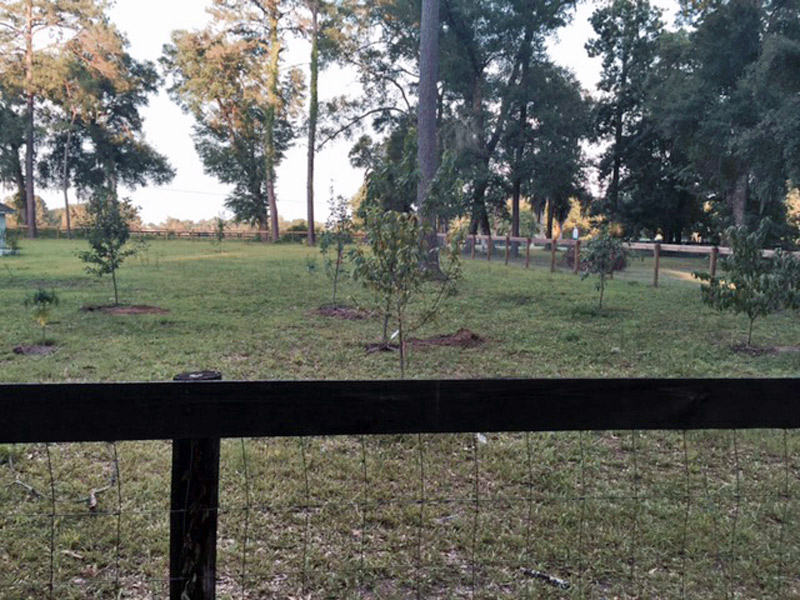
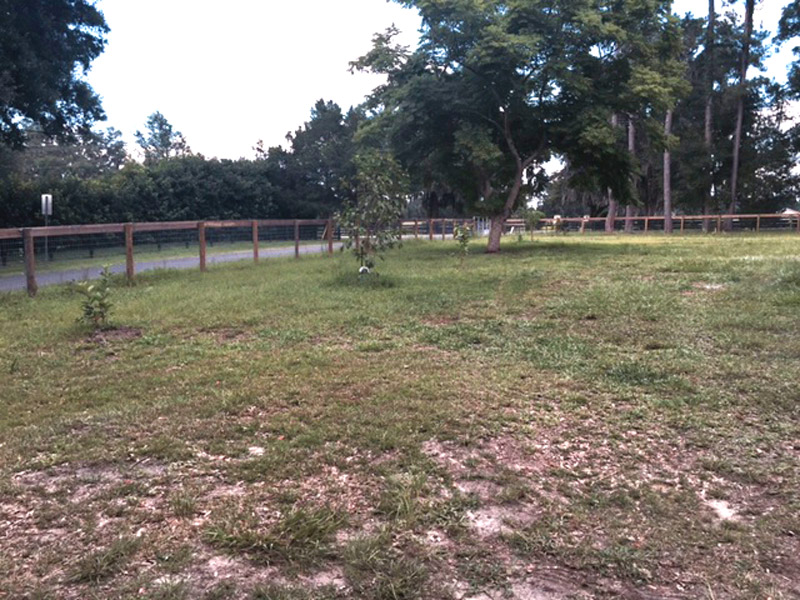
Does anything stand out to you in those photos?
Two things are there that I noticed immediately:
Patchy sand and pine trees.
Both are usually indicators of less-than-perfect soil for gardening and orchards. When even the weeds aren’t happy, cultivated trees and shrubs need more love than might be the case in someplace rich.
When I helped Dad create The Great South Florida Food Forest Project, we piled up all the yard “waste” around all the trees, turning sand into crumbly black compost-enriched soil in a matter of months:
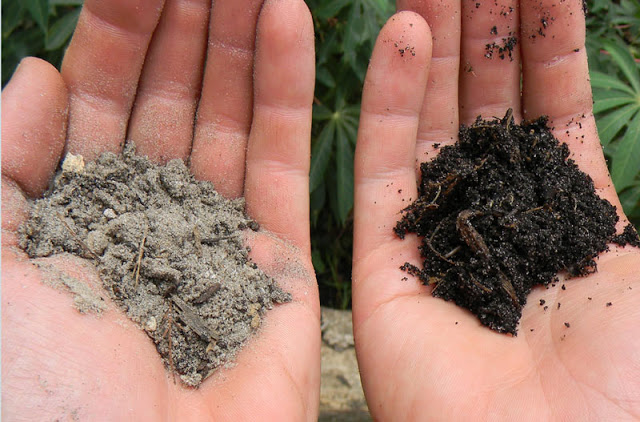
So, what’s a gal supposed to do when she has a ton of space and a wide range of species to fertilize?
Let’s jump in.
Mulch and Microbes
H. D. wrote in a follow-up email: “All of my plants are in desperate need of more love. I plan to begin fertilizing them asap.”
After watering, fertilizing is the next most important part of getting your orchard established.
My yard in North Florida was much like hers. It was a patchy, weedy, pasture-like expanse of stickers and grass. I used chemical fertilizer because I was so frustrated… and little happened. It may have been “proper fertilizing” by the modern farming book but there was something still missing.
The biggest change happened for my trees when I mulched them all heavily with the mulch from a tree company that was clearing the lines along our road.
I’m starting to see that the fungi and bacteria in the soil are at least as important as the minerals we add. A forest stays green and happy without any fertilizer being applied. All of the organic matter that is falling to the ground is utilized first by microorganisms and then reabsorbed by the roots of plants.
I would give each one of those trees a foot of mulch around them, at least up to 4′ out from the trunk of each one. A big ring.
Do this after a really good rain or after you soak the ground, then water that mulch in really well as well. Adding some handfuls of leaf mould gathered from around the base of happy trees in the nearby woods is a good idea as well. Sprinkle it around the trees, water, then mulch immediately so it doesn’t dry out. There are relationships happening between trees, fungi and bacteria that we hardly understand. Getting trees growing in pasture takes time but it’s jump-started by the invigoration of the soil around them with the type of organisms that live in harmony with trees.
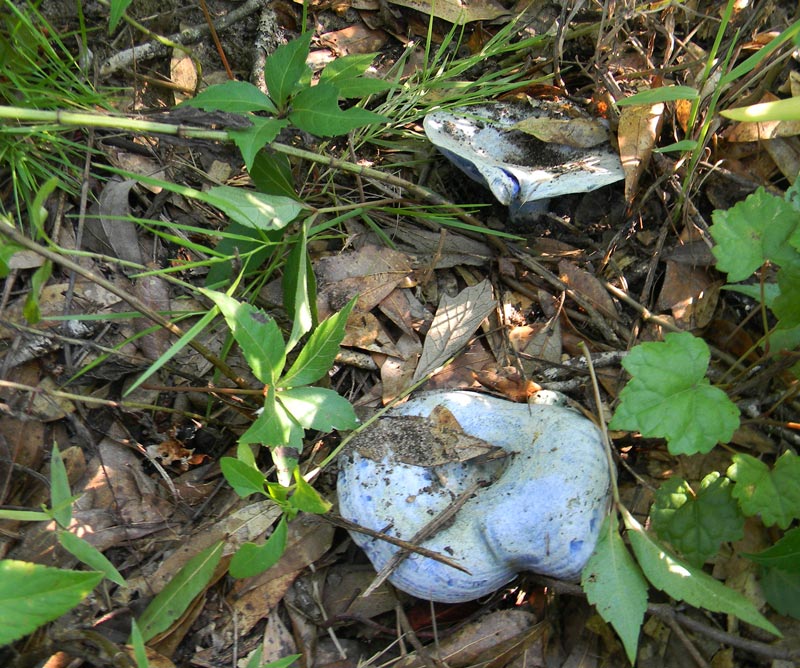
Think of it like eating live foods, such as yogurt, kombucha, homemade vinegar or sauerkraut. The organisms in those foods make your gut healthy. A wide soil web makes your trees healthy and helps them “digest” the nutrients that are available.
I’m actually experimenting right now with this method of culturing microbes and will post more on it tomorrow.
Check out the video I just posted:
Mulch as Fertilizer
In my book Compost Everything: The Good Guide to Extreme Composting (now available in audiobook, by the way), I have a chapter on growing your own compost.
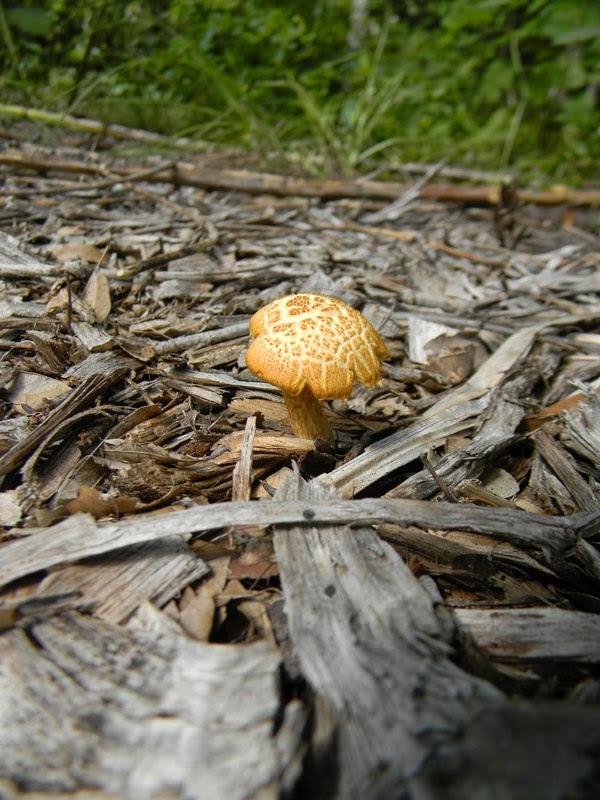
I view mulch as both a covering for the ground and a fertilizer, which is why I like to mulch with materials that are organic and do not take a super-long time to break down. A mix of species, as found in tree company mulch, is great. It might have pine, oak, cabbage palms, vines, bay trees and who knows what other species. Hard and soft woods, large and small pieces, different plants with different mineral contents: this is great for nutrition, worms, fungi and your trees.
Even just letting patches of weeds and grass grow, then chopping them down and throwing them around the base of your trees is GREAT!
I grow Mexican sunflowers for this reason, letting them grow large, then cutting them down, then letting them grow back again. All the chopped pieces are thrown around my fruit trees and act as a year-round slow release fertilizer. You can see me doing this in my film Compost Everything: The Movie, in which I demonstrate and talk about many of the methods I share in my book.
Plants work hard to grab what they need from the soil. When they grow large, you can just cut them down and feed them to your trees. A perfectly mown and tended lawn isn’t good for gathering this kind of biomass, but tall weeds and forests are.
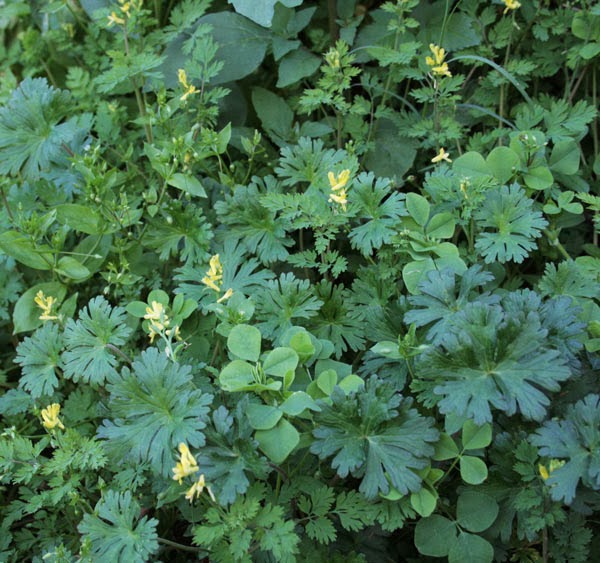
So – lesson one for getting trees going: mulch!!!
Feeding Faster
When trees and shrubs really look like they need a pick-me-up, or if you’re just getting a system started, as H. D. is, it’s time to pull out the big guns.
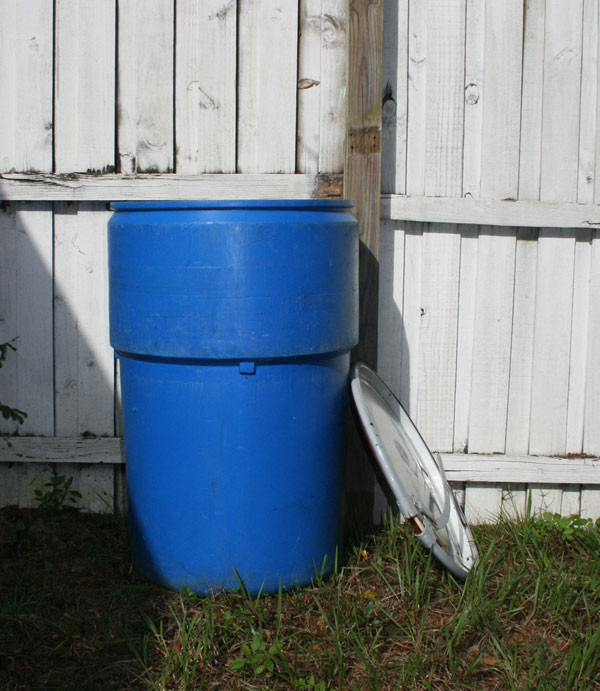
My favorite way to feed trees, shrubs and gardens is with a big barrel of liquid anaerobic compost fertilizer.
You can read more about my “recipe” in this post.
I put barrels near where I’d like to feed plants and let them sit out in the field, topping off with water and new ingredients as needed.
Manure, compost, urine, fish, seaweed and Epsom salts make for incredible fertilizing power. Make it and pour it around your trees, right into the mulch, then see what happens.
Some Final Thoughts on Proper Fertilizing
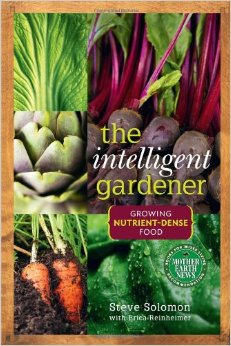 Though you may feed your trees and green them up, there’s always the possibility that there are still some micronutrients missing. This concept was really driven home in my mind when I read Steve Solomon and Erica Reinheimer’s book The Intelligent Gardener.
Though you may feed your trees and green them up, there’s always the possibility that there are still some micronutrients missing. This concept was really driven home in my mind when I read Steve Solomon and Erica Reinheimer’s book The Intelligent Gardener.
Before reading it, I never thought all that hard about the many minerals our plants need and how they relate to our own health. I scattered as many different sources of fertilty around my gardens from kelp meal to eggshells, stew bones to weed tea… but Solomon and Reinheimer literally turned it into a science.
They advocate fertilizing to specific ratios as based on complete soil tests, which if you’re a data geek and love that sort of thing, you may want to do.
I just keep switching all the ingredient in my compost tea barrels like an anarchist since getting that deep into numbers isn’t good for me.
Here are my final thoughts:
Mulch well; then get some rich tea going or a good organic mix of fertilizer; then hit your trees every month from February through August; then quit so they can safely enter dormancy.
For blueberries, throw on elemental sulfur and all the coffee grounds and mulch with all the rotten pine bark you can scavenge.
Don’t throw away any logs or leaves. Instead, put them around the bases of your trees to feed the fungi and good guys long-term.
You will succeed – it’s just a matter of growing trees like they grow in a forest… plus giving them a good hit of fertility so they can win their battle against the grass and the brutal Florida weather. Proper fertilizing the way nature does it – with a few tweaks – will make it happen!

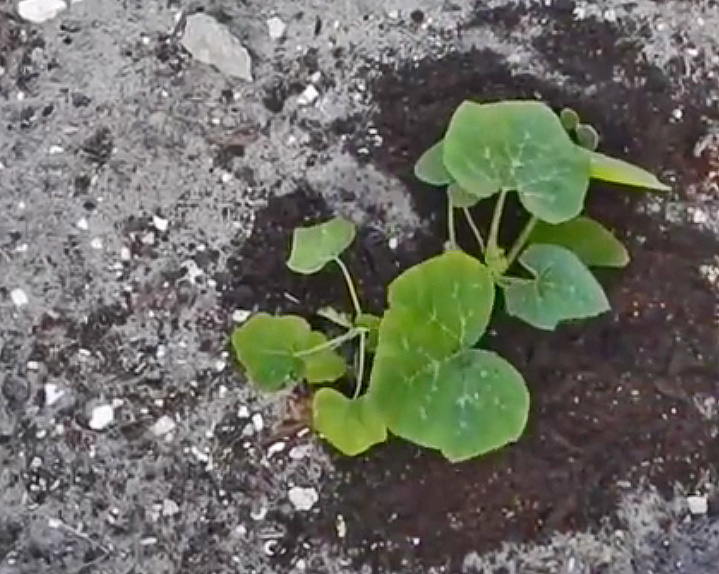
13 comments
I have been feeding my horses “sprayed”hay- how long before the bad stuff is out of their system if I begin to give them legume hay so I can use their manure
I can’t say for sure, but I would guess you’d be safe in a couple of days. Be very careful about any of the old muck getting in with the new, though.
Have you ever had anyone stop you from taking mulch from a forest area? And how did you get the tree clippings? Did you just ask workers you saw?
I ask ahead of time. Most people who own some woods really don’t mind.
With the tree trimmings I just asked the folks clearing the lines to dump their trucks in my yard – got 6 dumptrucks full that way. And I threw the driver $20 as a thank you. You can also call local tree trimming companies and ask about mulch. I have also been known to empty all the neighbor’s yard “waste” bins into my own yard.
Meh. You know by now to ignore the haters.
“Quasi-purism does not feed your kids” – Some programming-related post somewhere long ago
“I just keep switching all the ingredient in my compost tea barrels like an anarchist”
Anarchy FTW!!!
Yep, I do this with miscellaneous weed tea and any organic matter. Food scraps. Duck water.
Sure smells horrible, keep it away from the house. Dilute it.
Thank you. Heck yeah.
Duck water is THE BOMB! I want to get ducks again just for the fertilizer they make.
Hi David, will any tree limbs work for mulching around the trees I’m growing? I have a lot of Camphor trees in my yard that I’m cutting and pulling up. Do they have the ability to feed, or are they too noxious and will hurt my plants? They just seem like they are to “chemical” smelly to be good.
It seems to be safe. I know people that have used them as logs in their gardens without issue. I also found this:
“Workers with Tweed Shire Council have seen no difference in the growth of plantings between those mulched with camphor laurel chips and those mulched with chips of other species. In addition, the Florida Conservation Lodge Foundation chips camphor laurel into mulch for landscaping. So evidence suggests that shredded camphor laurel is safe to use as mulch.” Source: http://sesl.com.au/blog/is-camphor-laurel-mulch-toxic/
Thanks, thats awesome news, I have a never ending supply to use!
In your video on proper fertilizing, you mentioned adding epsom salts and borax. How much of each would you add to the amount of fertilizer that you mixed in the bucket?
I have been re-inspired to tackle the infertile soil in my S FL backyard as a result of watching your videos. Many thanks.
I only add a little borax as it becomes too much rather quickly and can cause trouble. In a five-gallon bucket I might add a tablespoon. With Epsom salt you could easily add a couple of cups without issue. I have friends that put a half cup of Epsom Salt scattered on the ground under each of their rose bushes and the roses do fine. The best book on really getting the percentages and nutrients balanced is Steve Solomon’s Intelligent Gardener book, as I’ve mentioned. It’s a little more math than I usually do but I tested his fertilizing recommendations and they work quite well. You can make that South Florida sand something great if you keep it covered all the time with organic matter and keep adding nutrition. It burns out all the organic matter really quickly if it’s baking in the sun without mulch. Gather all the leaves, twigs and even logs you can find, then stack them up. If you can get some clay from up north somewhere and mix a slurry of it with your compost it will also help keep humus in the soil a lot longer.
DTG,
In your video, you created a small amount of fertilizer for a small garden patch. If I want to mix up a large batch to cover a wider area, what ratios of the various ingredients would you recommend? Please include the Epsom salts and the Borax ratios as well.
Get this book: http://amzn.to/29MtqdT
That’s got the best set of ratios and ideas I’ve ever seen. I don’t have it with me here or I would let you know the proper ratios, but Solomon is the guy that worked it all out. The book is a mind opener all around.
Comments are closed.